For The Welfare, Happiness, Peace of All Sentient and Non-Sentient Beings and for them to Attain Eternal Peace as Final Goal. at
KUSHINARA NIBBANA BHUMI PAGODA-is a 18 feet Dia All White Pagoda with a table or, but be sure to having above head level based on the usual use of the room.
in 116 CLASSICAL LANGUAGES and planning to project Therevada Tipitaka in
Buddha’s own words and Important Places like Lumbini, Bodh
gaya,Saranath, Kushinara, Etc., in 3D 360 degree circle vision akin to
Circarama
When
you are in Bengaluru you are most welcome to visit Kushinara Nibbana Bhumi Pagoda
At
WHITE HOME
668, 5A main Road, 8th Cross, HAL III Stage,
Prabuddha Bharat Puniya Bhumi Bengaluru
Magadhi Karnataka State
PRABUDDHA BHARAT
May you, your family members and all sentient and non sentient beings be ever happy, well and secure!
May all live for 150 years
with NAD pills to be available in 2020 at a price of a cup of coffee
according to research doctors at Sydney!
May all have calm, quiet, alert and attentive and have equanimity mind with a clear understanding that everything is changing!
Suttas word by word
&
one occasion, the Bhagavā was staying at Bārāṇasi in the Deer Grove at
Isipatana. There, he addressed the group of five bhikkhus:
Rūpa, bhikkhus, is anatta. And if this rūpa were atta, bhikkhus, this
rūpa would not lend itself to dis·ease, and it could [be said] of rūpa:
‘Let my rūpa be thus, let my rūpa not be thus.’ But it is because rūpa
is anatta that rūpa lends itself to dis·ease, and that it cannot [be
said] of rūpa: ‘Let my rūpa be thus, let my rūpa not be thus.’
bhikkhus, is anatta. And if this vedanā were atta, bhikkhus, this
vedanā would not lend itself to dis·ease, and it could [be said] of
vedanā: ‘Let my vedanā be thus, let my vedanā not be thus.’ But it is
because vedanā is anatta that vedanā lends itself to dis·ease, and that
it cannot [be said] of vedanā: ‘Let my vedanā be thus, let my vedanā not
be thus.’
bhikkhus, is anatta. And if this saññā were atta, bhikkhus, this saññā
would not lend itself to dis·ease, and it could [be said] of saññā: ‘Let
my saññā be thus, let my saññā not be thus.’ But it is because saññā is
anatta that saññā lends itself to dis·ease, and that it cannot [be
said] of saññā: ‘Let my saññā be thus, let my saññā not be thus.’
bhikkhus, are anatta. And if these saṅkhāras were atta, bhikkhus, these
saṅkhāras would not lend themselves to dis·ease, and it could [be said]
of saṅkhāras: ‘Let my saṅkhāras be thus, let my saṅkhāras not be thus.’
But it is because saṅkhāras are anatta that saṅkhāras lend themselves
to dis·ease, and that it cannot [be said] of saṅkhāras: ‘Let my
saṅkhāras be thus, let my saṅkhāras not be thus.’
bhikkhus, is anatta. And if this viññāṇa were atta, bhikkhus, this
viññāṇa would not lend itself to dis·ease, and it could [be said] of
viññāṇa: ‘Let my viññāṇa be thus, let my viññāṇa not be thus.’ But it is
because viññāṇa is anatta that viññāṇa lends itself to dis·ease, and
that it cannot [be said] of viññāṇa: ‘Let my viññāṇa be thus, let my
viññāṇa not be thus.’
And that which is anicca, dukkha, by nature subject to change, is it
proper to regard it as: ‘This is mine. I am this. This is my atta?’
And that which is anicca, dukkha, by nature subject to change, is it
proper to regard it as: ‘This is mine. I am this. This is my atta?’
And that which is anicca, dukkha, by nature subject to change, is it
proper to regard it as: ‘This is mine. I am this. This is my atta?’
And that which is anicca, dukkha, by nature subject to change, is it
proper to regard it as: ‘This is mine. I am this. This is my atta?’
And that which is anicca, dukkha, by nature subject to change, is it
proper to regard it as: ‘This is mine. I am this. This is my atta?’
Therefore, bhikkhus, whatever rūpa, be it past, future, or present,
internal or external, gross or subtle, inferior or exalted, far or near,
any rūpa is to be seen yathā·bhūtaṃ with proper paññā in this way:
‘This is not mine, I am not this, this is not my atta.’
vedanā, be it past, future, or present, internal or external, gross or
subtle, inferior or exalted, far or near, any vedanā is to be seen
yathā·bhūtaṃ with proper paññā in this way: ‘This is not mine, I am not
this, this is not my atta.’
saññā, be it past, future, or present, internal or external, gross or
subtle, inferior or exalted, far or near, any saññā is to be seen
yathā·bhūtaṃ with proper paññā in this way: ‘This is not mine, I am not
this, this is not my atta.’
saṅkhāras, be them past, future, or present, internal or external,
gross or subtle, inferior or exalted, far or near, any saṅkhāras are to
be seen yathā·bhūtaṃ with proper paññā in this way: ‘This is not mine, I
am not this, this is not my atta.’
viññāṇa, be it past, future, or present, internal or external, gross or
subtle, inferior or exalted, far or near, any viññāṇa is to be seen
yathā·bhūtaṃ with proper paññā in this way: ‘This is not mine, I am not
this, this is not my atta.’Seeing thus, an instructed noble disciple
gets disenchanted with rūpa, disenchanted with vedanā, disenchanted with
saññā, disenchanted with saṅkhāras, disenchanted with viññāṇa. Being
disenchanted, he becomes dispassionate. Through dispassion, he is
liberated. With liberation, there is the ñāṇa: ‘Liberated.’ He
understands: ‘Birth is ended, the brahmic life has been lived, what was
to be done has been done, there is nothing more for this existence.’
while this exposition was being given, the cittas of the group of five
bhikkhus, by not clinging, were liberated from the āsavas.
Lakkhana Sutta is the second discourse given by the Buddha. It
describes the non-self characteristic of the five aggregates. This video
includes the English translation with Pali chanting
10 Famous Buddha Statues
The
study of Buddhism has inspired some of the world’s most beautiful
contributions to the world of art, most notable in the form of statues
known as Buddharupa (literally, the form of the Awakened One) that adorn
Buddhist temples of worship. Listed here are ten of the world’s most
famous and beautiful statues celebrating the Awakened One and his
message of peace.
10. Hussain Sagar Buddha Statue
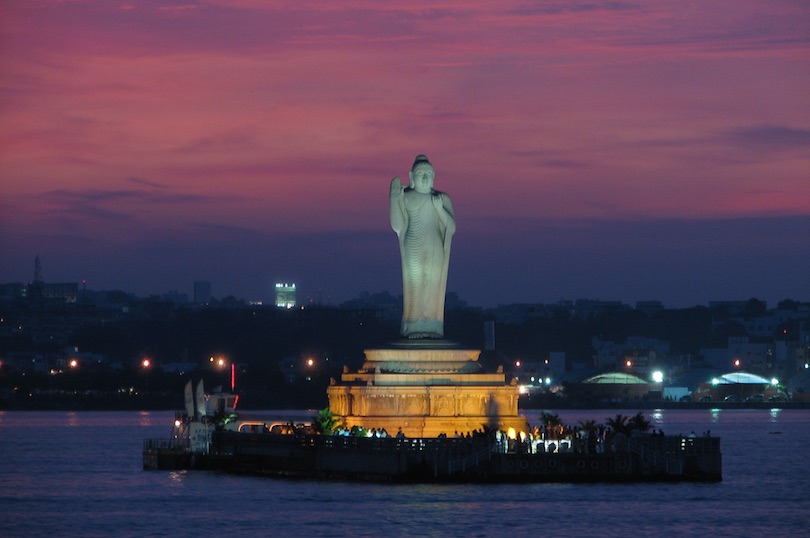
city of Hyderabad is one of India’s most famous Buddha statues. This
figure stands at a full 17 meters (56 feet) tall and weighs 320 tons.
The single largest monolithic statue in all of India, it was sculpted by
a group of artisans from a single piece of stone. Tragically, during
the statue’s installation in 1992 the figure tipped over and fell into
the lake, causing the death of 8 workers. The government recovered the
statue and restored it to its full height and stature.
9. Tian Tan Buddha Statue
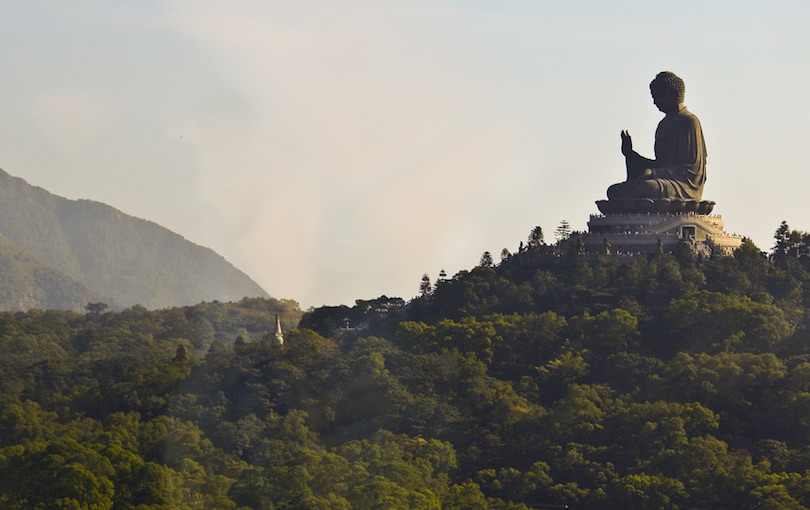
Tian Tan Buddha sometimes locally referred to as the Big Buddha, is
located on Lantau Island, in Hong Kong. Fashioned of bronze and
completed in 1993, The statue is the main feature of the Po Lin
Monastery, symbolizing harmony between man, nature, people and religion.
The statue is named Tian Tan Buddha because its base is a replica of
Tian Tan, the Temple of Heaven in Beijing. The statue sits on a lotus
throne on top of a three tiered altar. At 34 meters (110 feet) tall, the
Tian Tan Buddha is presented in a posture of serenity. His right hand
is raised to remove affliction. His left hand rests on his knee,
representing happiness.
8. Monywa Buddhas

Monywa is a city in central Myanmar located on the banks of the
Chindwin River. Just east of the city is the Po Khaung Taung, a range of
hills where you can see the Monywa Buddha– the largest reclining Buddha
statue in the world. This colossal figure measures 90 meters (300 feet)
in length. The head alone is 60 feet high. The Monywa Buddha was
constructed in 1991 and is hollow inside, allowing visitors to walk
along from the head to the feet. Inside the figure are 9,000
one-foot-high metal images of the Buddha and his disciples, depicting
various representations of important events in the Buddha’s life.
Recently a gigantic standing Buddha statue was built on top of Po
Kaung Hills. At 132 meter (433 feet) high it is one of the largest
Buddha statues in the world.
7. Ayutthaya Buddha Head
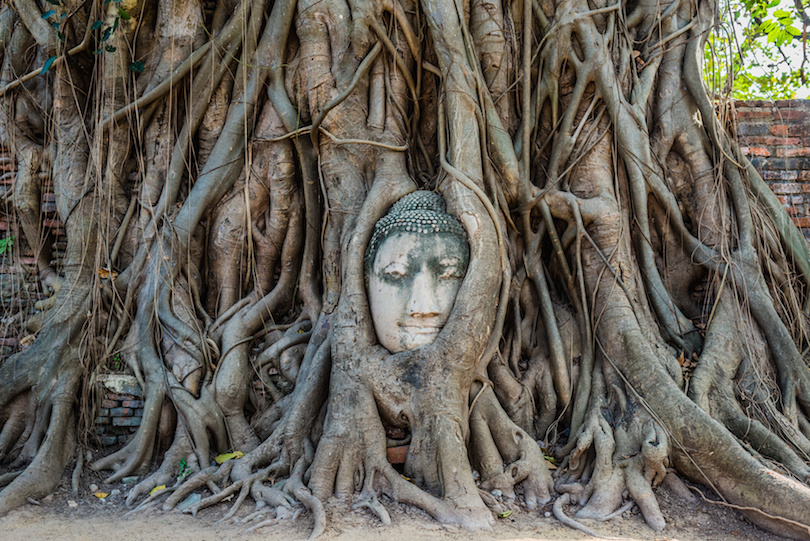
Thailand’s city of Ayutthaya is the location of one of the world’s
most unusual Buddhist statues. Among the ruins of Wat Mahathat (The
Temple of the Great Relic) is the remains of a sandstone statue of the
Buddha whose body has been lost to the ages but whose head rests
appropriately in the climbing roots and vines of a tree. Around this
famous figure are many other stature of the Ayutthaya period which have
survived the ravages of time.
6. Gal Viharaya
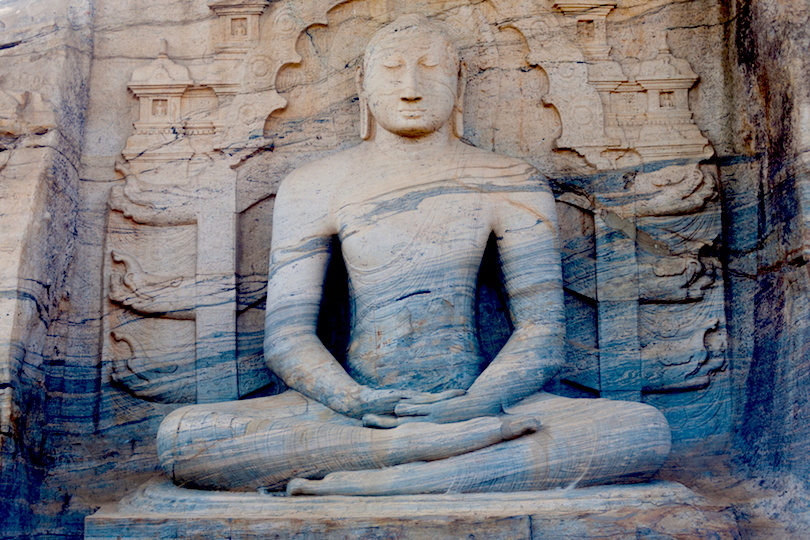
Located in north central Sri Lanka, Polonnaruwa is the site of one of
the most breathtaking of the world’s representations of the Buddha –
the Gal Gal Viharaya. This massive rock temple was constructed by
Parakramabahu the Great in the 12th century. The central attraction of
the temple are 4 large Buddha statues carved into the face of a granite
boulder. Among these giant stone figures are a reclining statue of the
Buddha that measures 14 meters (46 feet) in length and a standing figure
measuring 7 meters (23 feet) high.
5. Ushiku Daibutsu
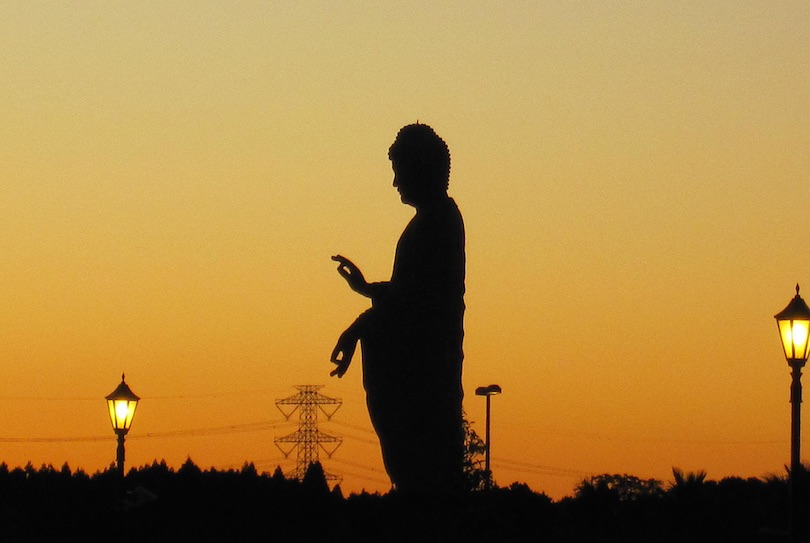
The Ushiku Daibutsu is located in the city of Ushiku in Japan.
Finished in 1995, the figure is one of the world’s tallest statues,
standing a total of 120 meters (394 feet) high including the 10m (30
foot) base and 10m high lotus platform. Visitors to the Buddha statue
can take an elevator to a platform where an observation deck is
situated. The bronze-plated figure depicts Amitabha Buddha, and is also
known as Ushiku Arcadia.
4. Temple of the Reclining Buddha
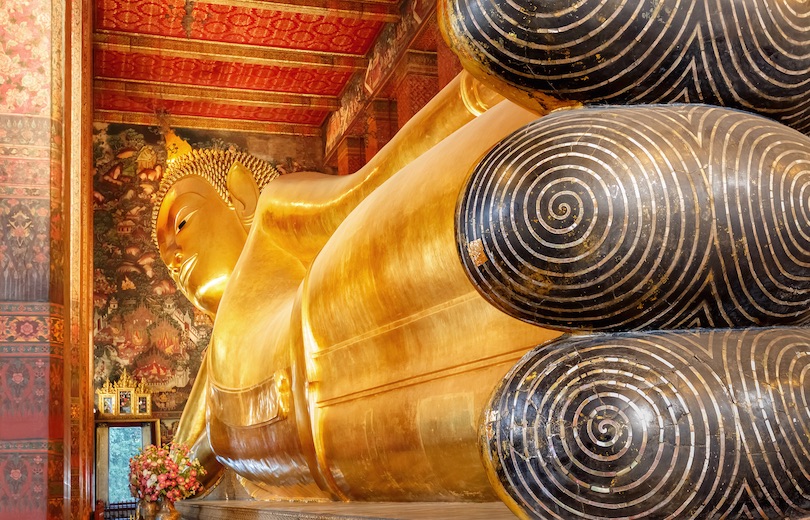
Located in Bangkok,
Wat Pho is famous for the huge Reclining Buddha statue it houses. It is
one of the largest temples in Bangkok and also one of the oldest,
constructed nearly 200 years before Bangkok became Thailand’s capital.
Wat Pho holds the distinction of having both Thailand’s largest
reclining Buddha image and the largest number of Buddha images in
Thailand. The gold-plated Reclining Buddha statue is 46 meters long and
15 meters high, and commemorates the passing of the Buddha into Nirvana.
The statue’s eyes and feet are decorated with engraved mother of pearl,
the soles of the feet displaying the 108 auspicious characteristics of
the true Buddha.
3. Great Buddha of Kamakura
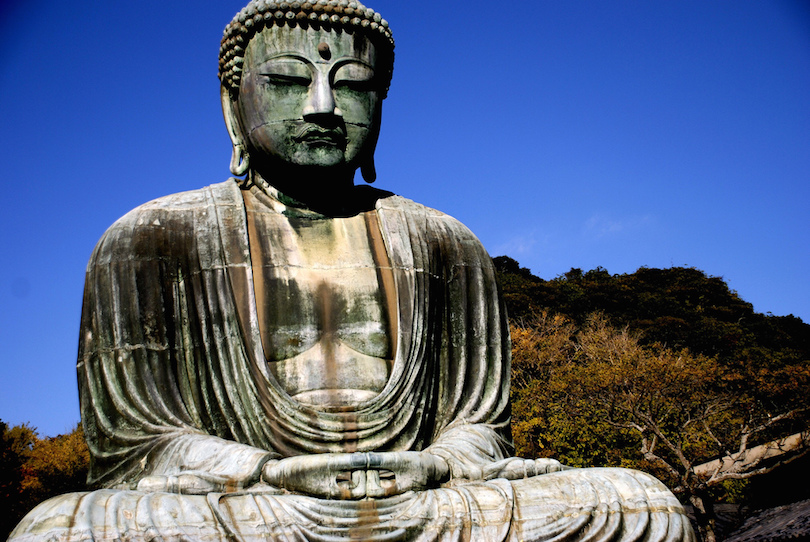
The Kotoku-in is a Buddhist temple of the Jodo shu sect located in the city of Kamakura
in Japan. The temple is famous for its great Buddhist statue (or
daibutsu). a colossal outdoor representation of Amida Buddha, one of
Japan’s most celebrated Buddhist figures. Cast in bronze, the Great
Buddha stands at over 13 meters (40 feet) high and weighs nearly 93
tons.
The statue reportedly dates from 1252 and is generally believed to
have been cast by the Buddhist monk Joko, who also collected donations
to build it. Although it originally was housed in a small wooden temple,
the Great Buddha now stands in the open air as the original temple was
washed away in a tsunami in the 15th century.
2. Temple of the Emerald Buddha
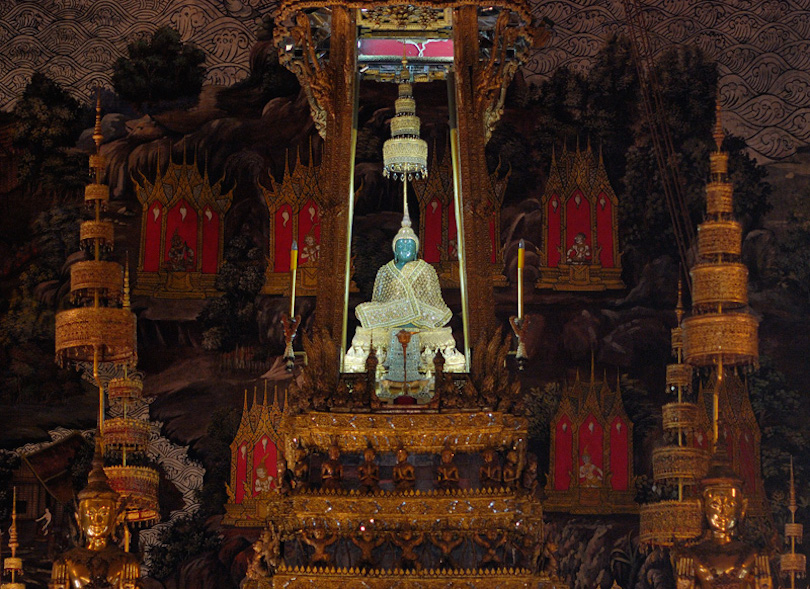
Another
of Bangkok’s Buddhist temples is Wat Phra Kaew, the Temple of the
Emerald Buddha, located within the grounds of the Grand Palace. The main
building is the central ubosoth, which houses The Emerald Buddha, one
of the oldest and most famous Buddha statues in the world.
A jade statue adorned in gold clothing, the Emerald Buddha was,
according to legend, created in India in 43 BC in the city of
Pataliputra, where it remained for 300 years. In the 4th century AD it
was taken away to Sri Lanka by Buddhist monks to save it from
destruction by war. Eventually the statue made its way to Thailand and
was moved to Wat Phra Kaew in 1779. The statue has three different sets
of gold clothing, which are changed by the King of Thailand in a
ceremony at the changing of the seasons.
1. Leshan Giant Buddha
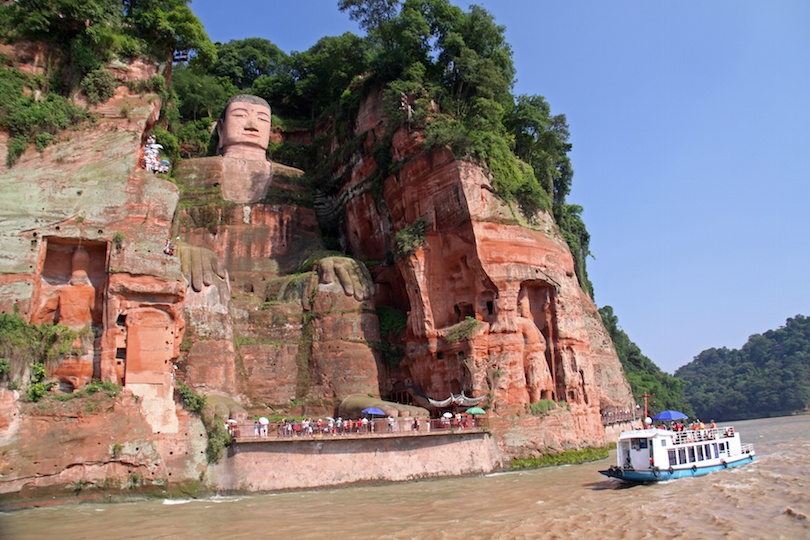
The Giant Buddha of Leshan is a gigantic Buddha statue carved out of a
cliff face in Sichuan, western China. The great sculpture is a figure
of Maitreya — a Bodhisattva traditionally represented in sitting
posture. Begun in the year 713 during the Tang Dynasty, the statue was
not completed until the year 803, and was the effort of thousands of
sculptors and workers. As the biggest carved stone Buddha in the world,
the Leshan Giant Buddha is featured in poetry, song and story. The
sculpture stands about 71 meters (233 feet) high and has three meter (11
feet) long fingers on each of its enormous resting hands. Today it is a
popular tourist attraction in China.

